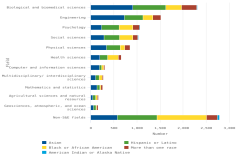Report
Glossary
Academia. Employment in academia includes 4-year colleges or universities; medical schools; university-affiliated research institutes; community or 2-year colleges; and foreign educational institutions.
Definite commitment. A commitment, through a contract or other method, by doctorate recipients to accept employment or a postdoctoral study or training (postdoc) position in the coming year or to return to predoctoral employment.
Definite non-postdoc employment commitment. A definite commitment by doctorate recipients for employment (excluding postdocs) in the coming year.
Expected stay rates. The proportion of temporary visa holder doctorate recipients with definite commitments in the United States at graduation among all temporary visa holders.
Field. Beginning in 2021, the SED collects over 1,600 fields for reporting of field of research doctorate, using a modified version of the 2020 Classification of Instructional Programs (CIP)—compared to 334 fields collected in 2020 and previous years. The SED-CIP codes were then aggregated into 306 detailed field codes nested into 68 major fields and 16 broad fields and are used to report field of doctorate data in the detailed data tables.
Trend broad field.
To facilitate trend data comparisons, historical field data were estimated based on a crosswalk of the new 2021 SED-CIP codes to the SED field of study codes used in prior survey years. The trend data reported in this report use 14 trend broad fields (excluding multidisciplinary/interdisciplinary sciences)—10 S&E fields: agricultural sciences and natural resources; biological and biomedical sciences; computer and information sciences; engineering; geosciences, atmospheric, and ocean sciences; health sciences; mathematics and statistics; physical sciences; psychology; social sciences; and 4 non-S&E fields: business, education, humanities and arts, and other non-S&E fields. (See “Field” under “Time series data changes” in the “Data source” section.)
Industry or business. Employment in industry or business includes positions where the principal employer is either a for-profit company or organization or self-employment.
NCSES. National Center for Science and Engineering Statistics.
Non-S&E. Non-science and engineering: Trend non-S&E broad fields used to compare data over time are based on historical fields that included business; education; humanities and arts (combined); and other non-S&E fields, such as communications.
Postdoctoral study or training (postdoc) position. A temporary position primarily for gaining additional education and training in research, usually awarded in academe, industry, government, or a nonprofit organization. Postdoc positions include fellowships; research apprenticeships; traineeships; internships (clinical residency); other training; and unspecified further training or study.
Race and ethnicity. Doctorate recipients who report Hispanic or Latino heritage, regardless of racial designation, are counted as Hispanic or Latino, and those who do not answer the Hispanic or Latino ethnicity question are counted as “ethnicity not reported.” Respondents who indicate that they are not Hispanic or Latino and indicate a single race are reported in their respective racial groups. Respondents who indicate they are not Hispanic or Latino and select two or more races are reported as "More than one race."
Research doctorate. A doctoral degree that is oriented toward preparing students to make original intellectual contributions in a field of study and that is not primarily intended for the practice of a profession. Research doctorates require the completion of a dissertation or equivalent project. In this report, the terms “doctorate” and “doctoral degree” are used to represent any of the research doctoral degrees covered by the SED. Professional doctoral degrees, such as the MD, DDS, JD, and PsyD, are not covered by the survey.
S&E. Science and engineering: Trend S&E broad fields used to compare data over time are based on 10 fields that include agricultural sciences and natural resources; biological and biomedical sciences; computer and information sciences; engineering; geosciences, atmospheric, and ocean sciences; health sciences; mathematics and statistics; physical sciences; psychology; and social sciences. The trend broad fields do not include multidisciplinary/interdisciplinary sciences, which was added to the SED field of study taxonomy in 2021.
Underrepresented minority. Demographic groups that are underrepresented in science and engineering, relative to their numbers in the U.S. population: American Indian or Alaska Native, Black or African American, and Hispanic or Latino. For detailed data on racial and ethnic representation, see the 2023 NCSES report Diversity and STEM: Women, Minorities, and Persons with Disabilities: 2023.
 An official website of the United States government
An official website of the United States government


















